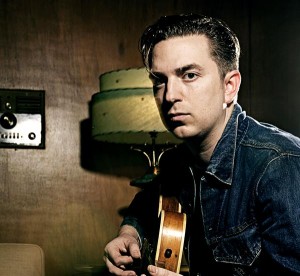JD McPherson: small town boy, big time talent
 In a musical era that can at times become tangled in its quest to discover the next great sound through effects, loops, distortion and ambient sounds, it is quite refreshing to hear raw talent, stripped down and laid bare. With sounds that are engaging and nostalgic, giving a respectful nod to music of decades past while exhibiting inventiveness and originality, JD McPherson’s album Signs and Signifiers encompasses his humble roots, his varied musical influences and his reverence for good old fashioned rock n roll. McPherson, as charming as he is talented, recently took some time out of his schedule to answer some of my burning questions.
In a musical era that can at times become tangled in its quest to discover the next great sound through effects, loops, distortion and ambient sounds, it is quite refreshing to hear raw talent, stripped down and laid bare. With sounds that are engaging and nostalgic, giving a respectful nod to music of decades past while exhibiting inventiveness and originality, JD McPherson’s album Signs and Signifiers encompasses his humble roots, his varied musical influences and his reverence for good old fashioned rock n roll. McPherson, as charming as he is talented, recently took some time out of his schedule to answer some of my burning questions.
As I’m from Texas and I know you’re from Oklahoma, I thought we would start with how being from the south has shaped your music?
Actually, Oklahoma is in a weird spot in where it is situated in the states. It is like the red-headed stepchild; people from the south don’t think it’s southern and people from the north don’t think it’s northern. Most of my time in the north has been spent in Chicago, which is still full of friendly people. I have not yet spent any time in NYC, so I am looking forward to that.
Have you always gravitated towards writing music that is heavily influenced by classic American rock?
When I was 13, one of my older brothers – an accomplished musician who does his own recordings – started teaching me how to play the guitar. Back then, I was into 70s rock and also punk rock. One of the first songs that I wrote was influenced by punk rock. A little later, I started listening to rock and roll and rockabilly, gravitating more towards those styles. There really is not that much difference between the styles; the chord structures tend to be the same. Both of my parents were church-going people, but it wasn’t until later that I started listening to gospel music.
What was your favorite concert that you attended?
My first Flaming Lips concert was pretty life changing. They were playing at an outdoor festival in Tulsa. I was in high school and didn’t even know who they were. The show was whacked out, psychedelic, a life-affirming experience.
I think it’s interesting and refreshing that you cite female singers among your influences.
I don’t really know why specifically I’m drawn to their voices; I just know that I like them. One of my favorite songs of all time is Ketty Lester’s – a singer from Arkansas- “Love Letters.†My love for this song has as much to do with the actual recording as it does with her voice. This next choice may seem silly to some people, but Connie Francis, with her very unique vocal thumbprint, also made it into my favorites. Some other of my favorite female voices include blues singer and guitarist from 20s Geeshie Wiley and a Jamaican woman named Phyllis Dilan – an active musician in the rock movement of the 60s. The 60s era was a good time for ballads in music; it produced a lot of really great female singers.
Did you ever have any vocal/instrumental training?
I lived in a very rural area so when I was in school, there was no funding for music or arts. But I was a schoolteacher for a little while, so I would ask the music teacher for vocal training tips. It’s mainly about warming up and practicing. When it comes to instrumental training, one of my older brothers, John Aaron taught me how to play the guitar. Also, a lot of uncles on my dad’s side were guitar closet style geniuses.
Is music the only avenue you have ever pursued?
I actually ended up going to art school. I have three different art degrees: an associate, a bachelor’s and a master’s degree in open media. I also taught for three years. I’ve even showcased some of my video art installations. But I am now focused on music.
What was your musical philosophy for this album?
Well, as much as I loved 70s rock, the really long elaborate drawn out solo sections didn’t appeal to me. I gravitated towards punk rock because it afforded people economic freedom – the chance to doing everything yourself. I do think that The Clash in general is beyond reproach; they never let themselves be pigeonholed; they reinvented themselves with every album, drawing from a dozen different musical styles. They were completely unafraid to put everything out there, always experimenting. And that’s what we were going for with this album, fearlessness. Although it is rooted in 50s American rock n’ roll, we switched it up on tracks like “Signs.â€
What hobbies, besides music and art, do you practice?
Every week that goes by, there is a new thing I get fixated on, whether it is comic books, magic tricks, Japanese Samurai books or guitar pedals that have no real purpose for my music. I am an avid collector.
Who would you want to headline a tour with and whom would you want to sit in with in a recording studio?
I would want to sit in with The Clash or The Stooges, and I would want to share a bill with James Brown and The Famous Flames.
Can you explain your songwriting process?
I hate reading about people who keep a book and just write down a song whenever it comes to them. When I write, it comes from the pressure of a deadline. In Chicago, we would record at night, and then I would stay up until three in the morning writing new songs for the next day. Having Jimmy Sutton on my team is great; I would give him the foundation of a musical idea, and then we would hash that idea out together.
Check him out live when he plays in NYC on August 4th at Mercury Lounge and August 5th at Southpaw. For more information on Jd McPherson and to listen to tracks off his album Signs and Signifiers, ckeck out his Myspace page.


